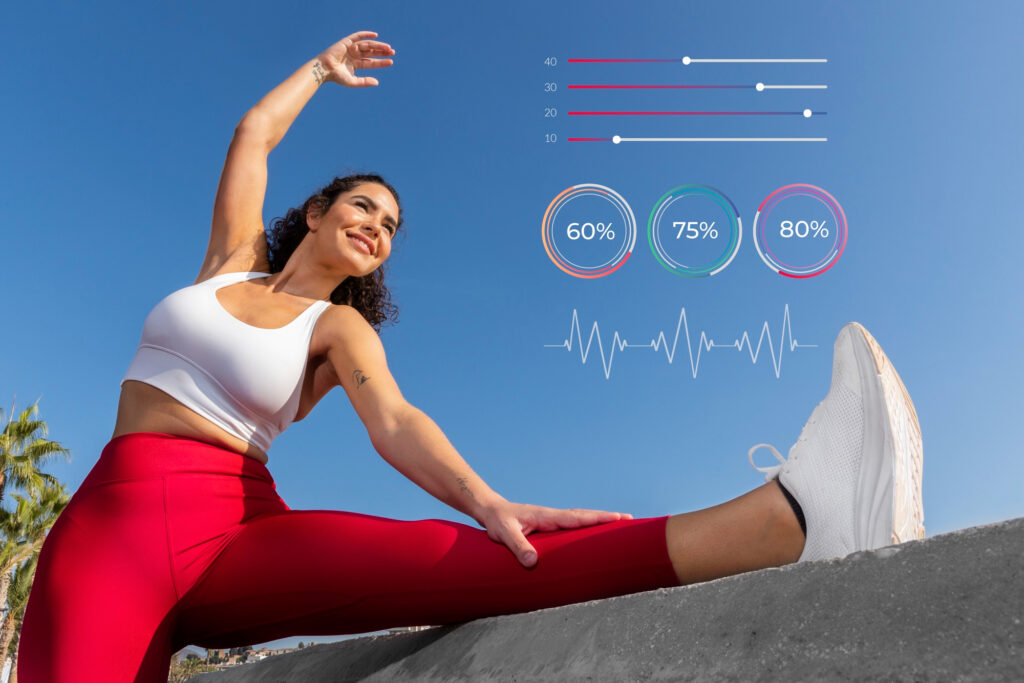
When it comes to exercise, understanding your heart rate can be incredibly helpful in reaching your fitness goals. Whether you’re trying to burn fat, improve your cardiovascular health, or increase your endurance, your heart rate plays a key role in determining how effective your workouts are. But what’s the difference between the heart rate zones for fat-burning and cardio? And how can you use this information to optimize your workouts?
In this article, we’ll break down everything you need to know about heart rate zones, how they relate to heart rate for fat burning vs cardio, and how to monitor and use your heart rate to get the most out of your exercise routine. We’ll keep it simple, so everyone can understand and apply this knowledge to their fitness journey.
Understanding Heart Rate Zones
Before diving into the specifics of fat-burning and cardio, it’s important to understand what heart rate zones are. Your heart rate is the number of times your heart beats per minute (BPM). During exercise, your heart rate increases as your body works harder. Heart rate zones are different ranges of heart rate that correspond to different levels of exercise intensity.

There are generally five heart rate zones, each representing a different level of intensity:
- Zone 1: Very Light Intensity (50-60% of Maximum Heart Rate)
This zone is often referred to as the “warm-up” zone. In this zone, you’re engaging in light activity, such as walking or stretching, which helps prepare your body for more intense exercise. - Zone 2: Light Intensity (60-70% of Maximum Heart Rate)
This is often called the “fat-burning zone” because your body uses fat as a primary fuel source at this intensity. In this zone, you’re working out at a comfortable pace, such as brisk walking or light jogging. - Zone 3: Moderate Intensity (70-80% of Maximum Heart Rate)
This zone is where you start to improve your cardiovascular fitness. You’re working at a moderate intensity, which is sustainable but challenging, like steady jogging or cycling. - Zone 4: High Intensity (80-90% of Maximum Heart Rate)
In this zone, you’re pushing your body hard. This level of intensity is typical for interval training or high-intensity workouts. It’s great for building endurance and burning calories quickly. - Zone 5: Maximum Intensity (90-100% of Maximum Heart Rate)
This is your maximum effort zone. You’re working as hard as you can, usually for short bursts, such as sprinting. It’s not sustainable for long periods and is often used in competitive sports or high-level training.
Also Read: What is Telemedicine and its Role in healthcare? A Comprehensive Guide
How to Calculate Your Maximum Heart Rate
To understand which zone you’re in, you first need to know your maximum heart rate (MHR). The most common way to estimate your maximum heart rate is to use the formula:
Maximum Heart Rate=220−your age\text{Maximum Heart Rate} = 220 – \text{your age}Maximum Heart Rate=220−your age
For example, if you’re 30 years old:
220−30=190 BPM220 – 30 = 190 \text{ BPM}220−30=190 BPM
So, your estimated maximum heart rate would be 190 beats per minute.
Using this number, you can calculate the heart rate ranges for each zone. For instance, if your maximum heart rate is 190 BPM:
- Zone 1 (50-60%): 95-114 BPM
- Zone 2 (60-70%): 114-133 BPM
- Zone 3 (70-80%): 133-152 BPM
- Zone 4 (80-90%): 152-171 BPM
- Zone 5 (90-100%): 171-190 BPM
What Is the Fat Burning Zone?
The fat-burning zone, often referred to as Zone 2 (60-70% of your maximum heart rate), is where your body primarily uses fat as a source of energy. When you exercise in this zone, your body burns a higher percentage of calories from fat compared to other energy sources like carbohydrates.

This happens because, at lower intensities, your body has enough oxygen to convert fat into energy efficiently. As the intensity increases (moving into higher heart rate zones), your body starts to rely more on carbohydrates because they can be broken down more quickly to meet the energy demands.
Example: If your goal is to lose weight by burning fat, spending more time in the fat-burning zone during your workouts might seem like the best strategy. However, while a higher percentage of fat is burned in this zone, the total number of calories burned is lower compared to more intense zones.
Also Read: What is Self-Reflection Meditation? A Comprehensive Exploration
What Is the Cardio Zone?
The cardio zone, usually considered Zone 3 (70-80% of your maximum heart rate), is where you focus on improving your cardiovascular fitness. In this zone, your heart and lungs are working harder to supply oxygen to your muscles, which helps strengthen your heart, increase lung capacity, and improve overall endurance.
In the cardio zone, your body starts to use a mix of carbohydrates and fats for energy. The intensity is higher than in the fat-burning zone, which means you burn more calories overall, even if the percentage of fat burned is lower.
Example: If your goal is to improve your endurance or overall fitness, spending time in the cardio zone is beneficial. You’ll burn more calories in this zone, which can also contribute to weight loss, but your primary focus is on building cardiovascular strength.
Comparing Fat-burning vs. Cardio Zones
Now that we know what the fat-burning and cardio zones are, let’s compare them:
- Fat-burning Zone (60-70% MHR):
- Burns a higher percentage of fat.
- Lower intensity, which is easier to sustain for longer periods.
- Ideal for beginners or those with specific goals related to fat loss.
- Cardio Zone (70-80% MHR):
- Burns more calories overall, including a mix of fat and carbohydrates.
- Higher intensity, which can be more challenging but leads to greater cardiovascular benefits.
- Ideal for improving fitness, endurance, and heart health.
Key Point: While the fat-burning zone is great for burning fat, spending time in the cardio zone can help you burn more calories overall, leading to greater fat loss over time.
How to Monitor Your Heart Rate
To effectively train in the fat-burning or cardio zones, it’s important to monitor your heart rate during exercise. Here are a few ways to do this:
Heart Rate Monitors
Heart rate monitors are one of the most accurate ways to track your heart rate during exercise. These devices typically come in two forms: chest straps and wrist-based monitors.
- Chest Straps: These are worn around your chest and measure your heart rate through electrodes. They are very accurate and are often used by serious athletes.
- Wrist-based Monitors: These are worn like a watch and use optical sensors to measure your heart rate through the skin. They are convenient and comfortable but may be slightly less accurate than chest straps.
For a list of recommended heart rate monitors, check out this guide from Runner’s World.
Fitness Apps and Smartwatches
Many fitness apps and smartwatches can track your heart rate and even provide real-time feedback during your workouts. These devices often allow you to set heart rate zones and will alert you when you’re entering or leaving a specific zone.
- Apple Watch: The Apple Watch has a built-in heart rate monitor and offers fitness tracking through the Apple Health app.
- Fitbit: Fitbit devices also track heart rate and provide insights into your workout intensity and progress over time.
For more information on fitness apps and smartwatches, visit this guide from CNET.
Manual Pulse Check
If you don’t have a heart rate monitor, you can manually check your pulse during exercise. To do this:
- Stop exercising and place two fingers on your wrist or neck.
- Count the number of beats in 15 seconds.
- Multiply this number by 4 to get your heart rate in beats per minute (BPM).
While this method is less convenient during intense exercise, it can still give you a rough estimate of your heart rate.
How to Train in the Fat-burning Zone
If your goal is to burn fat, focusing on workouts that keep your heart rate in the fat-burning zone can be effective. Here are some tips on how to do this:
- Low-Intensity Steady State (LISS) Cardio
LISS cardio involves exercising at a steady, low intensity for a longer period of time. This type of exercise is ideal for staying in the fat-burning zone.
- Examples: Brisk walking, light jogging, cycling at a comfortable pace, or using an elliptical machine at a moderate intensity.
- Duration: Aim for at least 30-60 minutes to maximize fat burning.
For more information on LISS cardio, visit this article from Verywell Fit.
- Consistency is Key
To see results, consistency is important. Try to incorporate fat-burning zone workouts into your routine at least 3-5 times per week. The more regularly you train in this zone, the more your body will adapt and become efficient at burning fat.
- Combine with a Healthy Diet
While exercising in the fat-burning zone can help you lose weight, combining it with a healthy diet is crucial. Focus on eating a balanced diet rich in whole foods, lean proteins, and healthy fats to support your fat-burning goals. Reducing your intake of processed foods, sugars, and unhealthy fats can also help you see better results.
For guidance on a balanced diet, you can visit ChooseMyPlate.gov for tips and meal planning resources.
How to Train in the Cardio Zone
If your goal is to improve your cardiovascular fitness or burn more calories overall, training in the cardio zone is an excellent choice. Here’s how you can effectively work out in this zone:
- High-Intensity Interval Training (HIIT)
HIIT is a popular training method that alternates between short bursts of intense exercise (often in the cardio zone or higher) and periods of rest or lower-intensity exercise. HIIT workouts are highly effective for improving cardiovascular fitness and burning a significant number of calories in a short period.

- Examples: Sprinting, circuit training, or cycling with intervals of high intensity followed by recovery periods.
- Duration: HIIT workouts are typically shorter, ranging from 20 to 30 minutes, because of their intensity.
For more information on HIIT, check out this guide from the American Council on Exercise.
- Steady-State Cardio at Moderate Intensity
In contrast to LISS, steady-state cardio at a moderate intensity keeps your heart rate in the cardio zone for an extended period. This type of workout is great for building endurance and improving overall cardiovascular health.
- Examples: Jogging, swimming, or cycling at a moderate pace.
- Duration: Aim for 30 to 60 minutes per session, depending on your fitness level and goals.
- Monitor Progress
As you train in the cardio zone, it’s important to monitor your progress to ensure you’re improving over time. Use a fitness tracker, heart rate monitor, or fitness app to keep track of your heart rate, workout duration, and intensity. Over time, you should notice improvements in your cardiovascular fitness, such as being able to sustain higher intensities for longer periods.
Balancing Fat-burning and Cardio in Your Workout Routine
Both fat-burning and cardio zones offer unique benefits, and the best approach is often to include a mix of both in your workout routine. Here’s how you can balance the two:
Alternate Between Zones
You can alternate between workouts in the fat-burning zone and the cardio zone throughout the week. For example:
- Monday: LISS cardio in the fat-burning zone (e.g., 45-minute brisk walk)
- Wednesday: Steady-state cardio in the cardio zone (e.g., 30-minute jog)
- Friday: HIIT workout (e.g., 20-minute interval training)
- Sunday: Another LISS cardio session (e.g., 60-minute bike ride)
Combine Zones in One Workout
Some workouts can combine both fat-burning and cardio zones. For example, you could start with a warm-up in the fat-burning zone, followed by a period of higher intensity in the cardio zone, and finish with a cool-down back in the fat-burning zone.
Listen to Your Body
While training in specific heart rate zones can be beneficial, it’s also important to listen to your body. If you’re feeling particularly tired or sore, it might be a good day to focus on lower-intensity exercise in the fat-burning zone. On days when you’re feeling strong and energized, you might push harder in the cardio zone.
The Role of Recovery
No matter which heart rate zone you’re training in, recovery is crucial for allowing your body to heal and grow stronger. Here’s how to ensure you’re recovering properly:
- Rest Days
Include at least one or two rest days per week in your workout routine. Rest days give your muscles time to repair and help prevent overtraining, which can lead to injury.
- Active Recovery
Active recovery involves low-intensity activities that help promote blood flow and reduce muscle stiffness without putting too much strain on your body. Activities like walking, yoga, or gentle stretching are great for active recovery.
- Proper Nutrition and Hydration
Fueling your body with the right nutrients is essential for recovery. Focus on consuming a balanced diet with plenty of protein, carbohydrates, and healthy fats. Staying hydrated is also crucial, especially after intense workouts.
For more tips on recovery, visit this article from Harvard Health.
Common Misconceptions About Fat-burning and Cardio
There are several misconceptions about the fat-burning and cardio zones that can lead to confusion. Let’s clear up a few of the most common ones:
- “You burn more fat by only staying in the fat-burning zone.”
While the fat-burning zone burns a higher percentage of calories from fat, it doesn’t necessarily mean you’ll burn more fat overall. Higher-intensity workouts in the cardio zone burn more calories overall, which can lead to greater fat loss over time.
- “Cardio is the only way to lose weight.”
Cardio is important for burning calories and improving fitness, but strength training and a healthy diet are also crucial for weight loss. Building muscle through strength training can increase your metabolism, helping you burn more calories even at rest.
- “You should always aim for your maximum heart rate during exercise.”
Training at your maximum heart rate (Zone 5) is only suitable for short bursts and is usually reserved for advanced athletes. Most people benefit more from training in Zones 2, 3, and 4, where they can sustain exercise for longer periods without risking injury.
Final Thoughts
Understanding the difference between the fat-burning and cardio heart rate zones can help you tailor your workouts to meet your specific fitness goals. Whether you’re aiming to burn fat, improve your cardiovascular health, or simply stay active, knowing how to use your heart rate effectively is a powerful tool.
By incorporating a mix of workouts in both the fat-burning and cardio zones, you can enjoy the benefits of each and create a balanced fitness routine that works for you. Remember to listen to your body, stay consistent, and make recovery a priority to achieve the best results.
For more information on heart rate training and fitness, check out this guide from the American Heart Association.
Happy exercising!
FAQ: Heart Rate for Fat-burning vs. Cardio: What to Know?
- What is the difference between the fat-burning and cardio heart rate zones?
The fat-burning zone typically falls between 60-70% of your maximum heart rate, where your body primarily uses fat as a fuel source. The cardio zone, on the other hand, is usually between 70-80% of your maximum heart rate, where the body starts using more carbohydrates along with fats for energy. The fat-burning zone is ideal for those who want to burn fat at a lower intensity, while the cardio zone is better for improving cardiovascular fitness and burning more calories overall, which can also contribute to fat loss.
- How can I calculate my maximum heart rate and the different heart rate zones?
Your maximum heart rate (MHR) can be estimated using the formula: 220 minus your age. For example, if you’re 30 years old, your MHR would be approximately 190 beats per minute (BPM). Once you have your MHR, you can calculate your heart rate zones by multiplying your MHR by the percentage ranges for each zone. For instance, the fat-burning zone (60-70% MHR) for a 30-year-old would be 114-133 BPM.
- Is it true that you burn more fat by staying in the fat-burning zone?
While the fat-burning zone does burn a higher percentage of calories from fat, this doesn’t necessarily mean you’ll lose more fat overall. The cardio zone burns more calories in total, which can lead to greater fat loss over time. The key is not just the percentage of fat burned, but the total number of calories burned, which is higher in the cardio zone due to the increased intensity.
- Can I lose weight effectively by only training in the fat-burning zone?
Training in the fat-burning zone can contribute to weight loss, especially if you combine it with a healthy diet. However, incorporating higher-intensity workouts in the cardio zone or through interval training (HIIT) can help you burn more calories overall and improve your fitness level, leading to more effective weight loss in the long run. A balanced workout routine that includes both fat-burning and cardio exercises is generally more effective for weight loss.
- How often should I train in the cardio zone to improve my fitness?
To improve your cardiovascular fitness, it’s recommended to engage in moderate to high-intensity cardio exercises (70-80% MHR) for at least 150 minutes per week, spread across several days. This could mean 30 minutes of cardio exercise five times a week. As your fitness improves, you can increase the intensity or duration of your workouts to continue challenging your cardiovascular system.
- What types of exercises are best for training in the fat-burning zone?
Exercises that keep your heart rate in the fat-burning zone include low to moderate-intensity activities that you can sustain for longer periods. Examples include brisk walking, light jogging, cycling at a moderate pace, swimming, and using the elliptical machine. These exercises help you stay in the fat-burning zone by maintaining a steady, manageable intensity level.
- What types of exercises are best for training in the cardio zone?
To train in the cardio zone, focus on moderate to high-intensity exercises that elevate your heart rate to 70-80% of your maximum. Examples include running, swimming at a faster pace, high-intensity interval training (HIIT), cycling at a vigorous pace, and aerobic classes. These activities improve cardiovascular fitness, burn more calories, and enhance endurance.
- How can I monitor my heart rate during exercise to stay in the right zone?
You can monitor your heart rate during exercise using heart rate monitors, fitness trackers, or smartwatches with built-in heart rate sensors. These devices provide real-time feedback and can alert you when you’re entering or leaving a specific heart rate zone. Alternatively, you can manually check your pulse by counting your heartbeats for 15 seconds and multiplying by four to get your BPM, though this method is less convenient during exercise.
- Should I focus more on fat-burning or cardio if my goal is overall health?
For overall health, a balanced approach that includes both fat-burning and cardio workouts is ideal. Fat-burning exercises can help with weight management and provide a steady, low-impact workout. Cardio exercises, on the other hand, improve heart health, increase endurance, and burn more calories. Combining both types of workouts ensures you address different aspects of fitness, leading to better overall health.
- Can heart rate training benefit beginners, or is it only for advanced athletes?
Heart rate training can benefit everyone, regardless of fitness level. For beginners, understanding and monitoring heart rate zones can help ensure that they are exercising at the right intensity to build endurance, burn fat, and avoid overexertion. As you progress, you can use heart rate training to push your limits, track improvements, and tailor your workouts to specific fitness goals. Whether you’re just starting out or are an experienced athlete, heart rate training is a valuable tool for optimizing your exercise routine.

